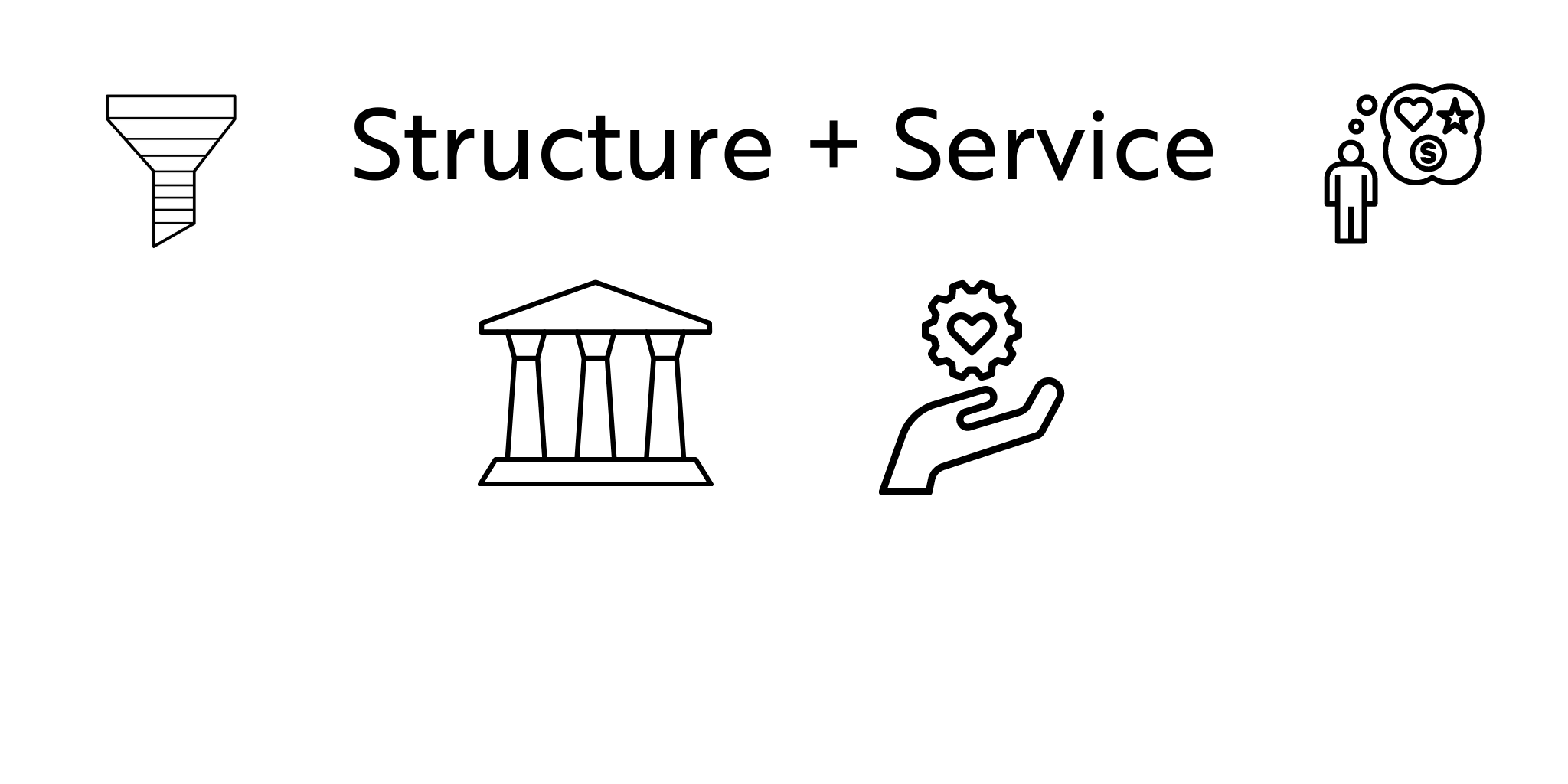What is Your Structure and who do you Serve?
What are you selling and who do you sell it to. That seems like a simple question but if you don't have your story straight, it can get confusing.

The 4 P’s of marketing (Product, Price, Promotion, and Place) are as old as well, marketing. Over the years, folks have morphed them into all sorts of other lists of the marketing mix like the 4p's, 7p's, and even the 4c's.
One thing that has remained constant and gotten more complicated is the product + place where you sell your offering. Back in the day, all things marketed were products -- even if they were services. In terms of place or the customers you service, it came down to either consumers or other businesses. Now, there can be a complex hybrid of 2 side market places and a vast array of channels (like Amazon) that muddies the water a bit. Can you see why we wanted to get most of our story straight before we tackled this?
Ideally, everything we have done up till now will apply to every structure of product or service and all channels you want to service. We know that’s a bold statement and frankly, it’s hard to get this all right but the fundamental fact is that if you have a big enough idea, it will span across everything you do.
What Exactly are You Selling?
Structure relates to what you are actually selling.
- Is it a physical product?
- A service.
- A subscription.
- Do you take donations?
- Or is it a hybrid?
What you sell determines how you talk about it. When we get to the conventions and requirements, you’ll see why it’s important that the offering be crafted properly or you’ll confuse people.
Why it might seem obvious what you are selling, say a Smart Water Monitor for your pool, it’s not obvious how that might be perceived from jobs to be done perspective. This also extends to adjacent offerings like upgrades, insurance, etc. All of these secondary offerings enhance the primary offering and the stories around them need to be consistent as well. Let’s take a look at some of the different types of offerings there are and how we can lay down the bones to structure the offering.
Laying Down the Bones
It’s important that the skeleton in which we put the flesh of your offering be well designed and familiar to those that might want to buy it. It’s the bones of your offering that have conventions and requirements that must be met or your prospects will get confused. We’ll discuss this more when we get to Conventions and Requirements, which is coming up later on. For now, let’s take a look at the different types of offerings and how they should be set up.
Product
Can be a physical or a digital product that gets delivered to the customer. If it’s a physical product, then things like shipping and handling need to be accounted for.
For information products (like classes, workshops, etc) that are not books or reports, there is usually a delivery platform that needs to be set up, and the customer is then given access to it.
Service
Services are either one time or recurring. A service could be task-based or retainer-based. Task-based services would be writing a blog post or an email. The deliverable is some sort of work product that’s clearly defined.
Retailer-based services are monthly fees paid to perform tasks or manage other that perform tasks. The definition of the tasks to complete are broad in scope and can change. These types of services need a combination of deliverables and metrics to show progress.
Subscription
Subscriptions are monthly fees for access to a platform or monthly delivery of physical products. Subscriptions require a way for customers to manage their subscriptions as well as get access to any kind of required metrics or data.
Donation
Non-profits take donations as their main source of revenue. Companies can also donate a certain amount of funds to a charity for buying their products and services.
Product-Subscription Hybrid
Some products like smartphones have both a physical product and a subscription to enable the physical product to work. There is a tight coupling between the two and one does not work without the other.
We’re sure we (and you) could come up with many more variations. What’s important to remember is that whatever you come up with, you’ll have to communicate to your prospects so that they understand what they are getting. Don’t underestimate the confusion your product structure can make with prospects.
Honing in On Your Offering
At Sutro, we have complex hardware + smartphone app + subscription + testing cartridges that all have to be communicated to our prospects. This gets even more complex when you have specials and deals or third party distributors. Our advice is to spend the time to map it out carefully and test, test, and test some more.
It took us the better part of 4 months to figure out that our Smart Monitor price point was turning people off. While this might seem obvious now, at the time we launched, there were several similar product types (premium products) that led the way. It was only after experimenting with “Try one for $1” that we realized we needed to give customers an option to pay monthly as opposed to all at once.
That one change, adding a leasing option, increased sales by at least double and also allowed pool professionals to offer the Smart Monitor to their customers without having the up front hardware costs. The reduction of friction is what we want to achieve as we build our Story Funnel.
Are You Being Served?
Once you have the structure of your offering nailed down, the next step is to figure out who you are going to sell it too. The rule on this is to focus on the end customer -- the one in which your product or service does the job. Again, seems obvious, but we see some brands focus their marketing efforts on distribution or resellers instead of building demand for the end customer.
End customer demand will pull along distribution and resellers. It’s also the best use of your time and marketing dollars since any activity that’s not close to the end customer will not be as effective.
The Company You Keep
Focusing on the end customer does not mean you ignore those stakeholders around the customer. In some cases, it’s those stakeholders that assist in making the decision. For example, if you own a pool, chances are that your spouse will be a major influence on the products and services you’ll buy for it. The same goes for anti-snoring devices or certain pharmaceuticals that help you “when the mood strikes.”
The influence these stakeholders have on the end customer will vary depending on the relationship. In some cases, as in a spouse, they are so close to the end customer that you can consider them end customers as well but with different goals.
In the anti-snoring example above, a spouse might have a vested interest in reducing their partner’s snoring so they can get a better night’s sleep. This, in turn, puts them in a better mood and/or gives them more energy. For the end customer, the snorer, a device that helps them sleep will improve their life as well.
Serving the End Customer
Take a look at your offering and find both the end customer, the person that will use it, and the stakeholders around them by answering the following questions:
- What are their wants and needs? How do they differ from what you determined before?
- How many steps is your brand removed from the end customer? This is important for brands that use distribution channels.
- What is the relationship between the end customers and the stakeholders around them? What influence do stakeholders have on the buy decision?
To serve the end customer, you’ll have to craft a story that hits all of the different parts of persuasion (Pathos, Logos, Ethos) all while not turning off the stakeholders around them.
In the end, you’ll have to experiment with what you think is the end customer and see how the messaging works. For some brands, it’s obvious but for others, it takes a bit of digging. Take Sutro for example.
It might seem obvious that the end customer will be a pool (or spa) owner, which is true but if you dig a little deeper, you’ll start to understand there are stakeholders around the end customer that influence them greatly.
Most DIY Pool (or Spa) folks are male. They take pride in their backyard and want their pool to be the centerpiece. Most are married and their spouse (usually a woman) also wants the pool to be kept up but for different reasons.
A Matter of Pride
A poorly maintained pool looks ugly and is unsafe. If you have kids (or grandkids), you want them to be safe in the pool. That starts with the water.
A perfectly maintained pool will reduce the chance of unsafe water, which in turn will make the end customer’s spouse happy to have her friends, kids or grandkids be in the pool. Without that guarantee, there will be a lot of tension in the household.
A product or service that can reduce or eliminate that tension is something that the end customer (the husband) wants. It’s also what the wife wants so both are in alignment on the end result which is a perfect pool that both can be proud of.
Now that we have discussed both the wants/needs and the structure + who you are serving, we can create the build part of the funnel that’s goal is to please and delight the customer by rapidly getting them using our offering with little to no friction.
Are you ready to simply and quickly get your new customers using your offering?

